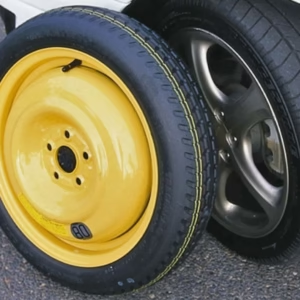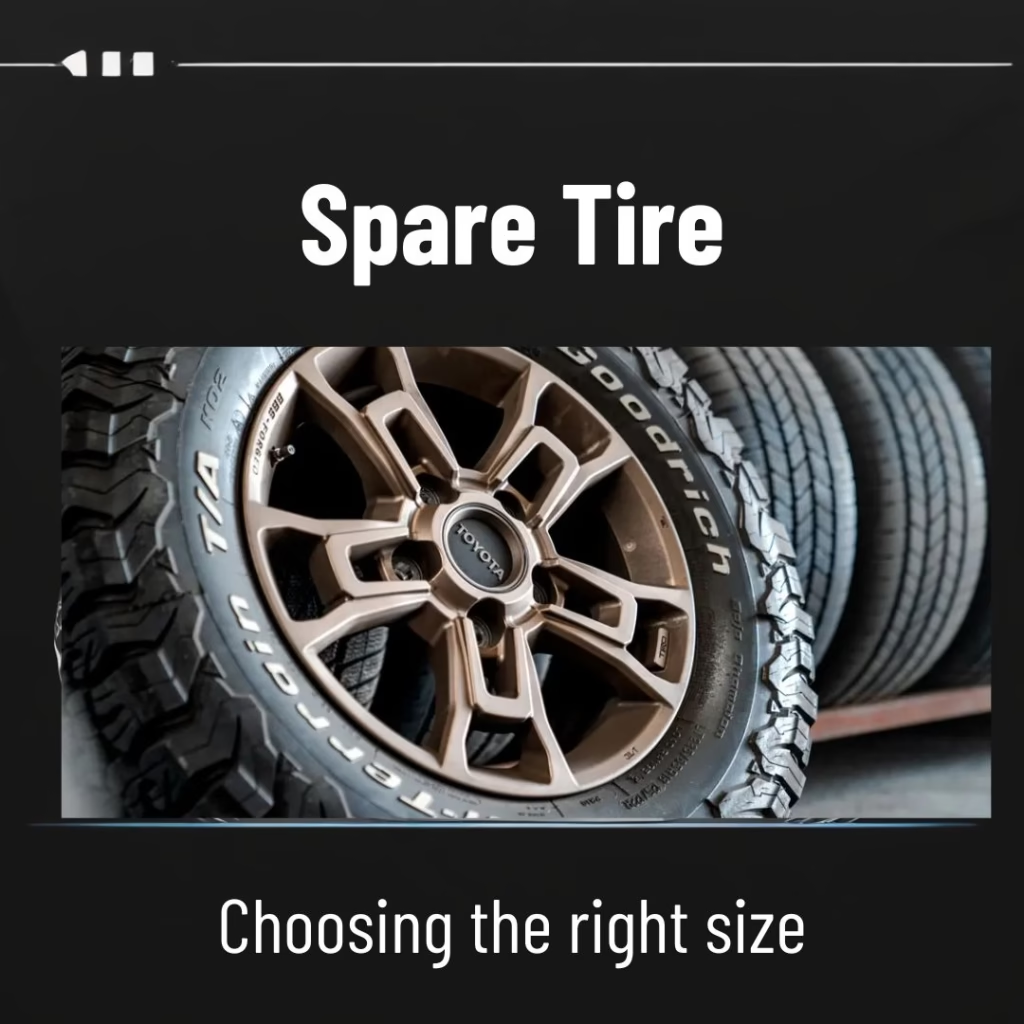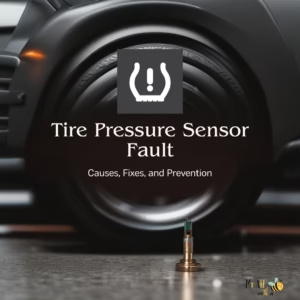Spare tires are crucial for maintaining vehicle safety and functionality. Knowing whether to choose a spare tire with a larger or smaller diameter for spare tire can significantly impact your decision when the need arises. In this blog, we will delve into the advantages and disadvantages of various spare tire sizes, providing you with the insights necessary to select the ideal option for your vehicle. Understanding these differences will empower you to make informed choices that enhance your driving experience and ensure your safety on the road.
Understanding Spare Tires
What Is a Spare Tire?
A spare tire is a backup tire specifically designed to temporarily replace a flat or damaged tire. It provides a crucial safety net, allowing you to continue your journey or reach a nearby repair shop without being stranded. Having a spare tire on hand can be a lifesaver in emergency situations, ensuring that you can handle unexpected tire issues with ease.
Types of Spare Tires

Full-Size Spare Tires
Full-size spare tires are designed to match the size and performance specifications of the regular tires on your vehicle. This means they offer the same grip, handling, and speed capabilities as your existing tires, allowing for a seamless transition in case of a flat. Full-size spares can be used for longer distances and at higher speeds, making them a versatile option for drivers who want a reliable backup.
- Speed Limitations: Full-size spare tires generally do not have strict speed limitations, as they match the specifications of your regular tires. However, it’s always advisable to follow the speed rating indicated on the tire.
- Distance Limitations: Since full-size spares are designed for longer use, they can typically be driven for hundreds of miles as long as the tire is in good condition.
Compact (Donut) Spare Tires
Compact or “donut” spare tires are smaller and lighter than standard tires. They are designed for temporary use and are ideal for situations where space and weight are considerations, such as in smaller vehicles. While they can get you back on the road quickly, they have limitations in terms of speed and distance. Typically, they are not meant for prolonged use and should be replaced with a standard tire as soon as possible.
- Speed Limitations: Compact spares are usually rated for a maximum speed of around 50 mph. Driving faster than this can lead to tire failure or decreased control of the vehicle.
- Distance Limitations: These tires are intended for temporary use and should not be driven for more than 70 miles. It’s essential to replace it with a full-size tire as soon as possible.
Temporary Spare Tires
Similar to compact spares, temporary spare tires are designed for short-term use. They are even more limited in terms of speed and distance, often recommended for speeds of no more than 50 mph and short distances—usually around 70 miles. Their lightweight design and compact size make them easy to store in your vehicle, but like donuts, they should only be used until you can replace them with a full-size tire.
- Speed Limitations: Similar to compact spares, temporary spares are also limited to a maximum speed of about 50 mph. Exceeding this speed can compromise safety and tire integrity.
- Distance Limitations: Temporary spares are designed for very short distances, typically around 50 to 70 miles. They should be replaced with a standard tire quickly to avoid potential issues.
Factors to Consider When Choosing Spare Tire Diameter
When selecting a spare tire, it’s crucial to consider various factors that can significantly affect your vehicle’s safety, performance, and handling. Here are some key aspects to keep in mind:
Vehicle Specifications
Always ensure that the spare tire you choose aligns with your vehicle’s specifications. Manufacturers design tires based on specific criteria to optimize safety and performance. This includes factors such as load capacity, tire pressure, and overall dimensions. When deciding between a larger or smaller diameter for spare tire, adhering to these specifications is essential to avoid compromised handling and potential safety hazards.
Handling and Performance
The diameter of your spare tire has a direct impact on your vehicle’s handling and performance. A larger diameter spare tire typically provides enhanced stability, particularly during cornering and in adverse weather conditions. Conversely, a smaller diameter for spare tires may negatively affect ride quality, leading to a harsher driving experience and potentially reduced traction. Consider how the choice of a larger or smaller diameter for a spare tire will impact your driving dynamics, especially if you frequently drive in challenging conditions.
Speed Limitations
Compact spare tires often come with specific speed restrictions due to their smaller size. These limitations can affect vehicle stability, particularly at higher speeds. For example, if a compact spare is rated for a maximum speed of 50 mph, exceeding this limit can result in diminished control and increased risk of tire failure. Always be mindful of these restrictions and adhere to them to ensure your safety while driving.
Compatibility with Existing Tires
Your spare tire should closely match the diameter and tread pattern of your existing tires for optimal safety and performance. Mismatched tires can lead to uneven wear, decreased traction, and instability, particularly when driving at higher speeds or during cornering. Additionally, having a spare tire with a similar tread pattern can enhance grip and handling characteristics. This is especially important when considering a larger or smaller diameter for a spare tire, as compatibility can significantly influence overall vehicle dynamics.
Larger or Smaller diameter for spare tire: Pros and Cons
When selecting a spare tire, understanding the benefits and drawbacks of both larger or smaller diameters for spare tire options is essential. Each type has unique characteristics that can affect your vehicle’s performance, handling, and convenience.
Larger Diameter Spare Tires
Advantages
- Better Ground Clearance: Larger diameters for spare tire options provide increased ground clearance, making them particularly useful for off-road driving or navigating uneven terrain. This feature helps prevent obstacles from damaging your vehicle’s undercarriage.
- Enhanced Stability: A larger spare tire contributes to improved stability, offering smoother handling in various driving conditions, including sharp turns and high-speed maneuvers. This stability is crucial for maintaining control, especially in adverse weather.
- Improved Performance: Larger-diameter spare tires often perform better in challenging conditions, such as snow or mud. Their increased surface area enhances traction, allowing for better grip on slippery or uneven surfaces.
Disadvantages
- Storage Challenges: One significant drawback of larger tires is that they may not fit comfortably in the designated spare tire compartment of your vehicle, leading to difficulties in storage and transport.
- Increased Wear: A larger spare tire can strain suspension components, potentially leading to premature wear and tear. This strain can affect overall vehicle performance and longevity.
- Reduced Fuel Efficiency: Larger diameters for spare tire options generally increase rolling resistance, which can negatively impact fuel efficiency. Drivers may notice a decrease in miles per gallon (MPG) when using a larger spare tire.
Smaller Diameter Spare Tires
Advantages
- Lightweight: Smaller diameter spare tires are easier to lift and handle, making them more convenient for changing a tire in an emergency. Their lightweight design is especially beneficial for those who may struggle with heavier tires.
- Space-Saving: Compact spare tires take up less room in the trunk or spare tire compartment, allowing for more cargo space and making it easier to transport other items.
- Cost-Effective: Typically, smaller-diameter spare tires are more affordable than full-size options, making them a cost-effective solution for drivers looking to save money on tire replacements.
Disadvantages
- Speed Restrictions: Smaller spare tires often come with speed limitations, making them unsuitable for high-speed driving. Exceeding these limits can lead to stability issues and increase the risk of tire failure.
- Reduced Traction: A smaller diameter spare tire generally offers less traction, especially in poor road conditions. This reduced stability can be a concern when driving in rain, snow, or on uneven surfaces.
-
Limited Safety: Smaller tires are not designed for extended use and can compromise safety if you rely on them for longer distances. Use them only temporarily until you can install a proper replacement tire.
Examples of Larger and Smaller Diameter Spare Tires
- Larger Diameter Spare Tire Example:
- Full-Size Spare Tire: If you drive a truck or SUV designed for off-road conditions, a full-size spare tire that matches your vehicle’s regular tires (e.g., 265/70R17) can be an excellent choice. This larger diameter provides better ground clearance and stability, making it suitable for rugged terrain. It allows you to drive at normal speeds without compromising safety, especially in emergencies.
-
Smaller Diameter Spare Tire Example:
- Compact (Donut) Spare Tire: In a compact car, a smaller diameter spare tire (e.g., 125/70D16) can be a practical solution. This lightweight donut tire is designed for temporary use and occupies less space in the trunk. While it’s easier to handle and store, it typically has speed limitations (around 50 mph) and is suitable only for short distances, making it ideal for quickly getting you to a nearby repair shop.
Conclusion
Spare tires are vital for ensuring vehicle safety and functionality. When faced with a flat, knowing whether to opt for a spare tire with a larger or smaller diameter for spare tire can significantly influence your decision. Each type of spare tire comes with its own set of advantages and disadvantages, impacting not only your driving experience but also your safety on the road.
Understanding the differences between larger or smaller diameters for spare tire options is essential. Larger spare tires generally offer better ground clearance, enhanced stability, and improved performance in challenging conditions. However, they may present storage challenges and increased wear on your vehicle. On the other hand, smaller-diameter spare tires are lightweight, space-saving, and cost-effective, but come with speed restrictions and limited safety for extended use.
Ultimately, carefully evaluating your needs and the specific features of each spare tire type will empower you to make an informed choice that ensures your safety and peace of mind while driving.
FAQs
- What is the purpose of a spare tire?
It provides a temporary replacement for a damaged tire, ensuring you can drive safely to a repair shop. - What are the types of spare tires?
Full-size spares, compact (donut) spares, and temporary spare tires. - Which is better: a larger or smaller diameter for the spare tire?
Larger tires offer stability, while smaller ones save space and are easier to handle. - How does tire diameter affect performance?
Larger diameters improve handling, while smaller ones may reduce stability and traction. - Can I use a spare tire permanently?
No, spare tires are designed only for temporary use. - Do smaller spare tires affect speed?
Yes, compact spares often come with speed restrictions due to their size and design. - Are larger spare tires harder to store?
Yes, larger tires may not fit in standard spare tire wells. - Are smaller spare tires cheaper?
Yes, smaller tires are typically more affordable than full-size spares. - What should I consider when buying a spare tire?
Match the tire size to your vehicle’s specifications and driving needs. - Can I use any size spare tire?
No, using an incorrect size can impact safety and performance.
If you like this post, you may also like
Thanks for reading, for more interesting articles, visit our homepage.







